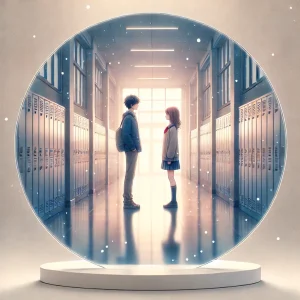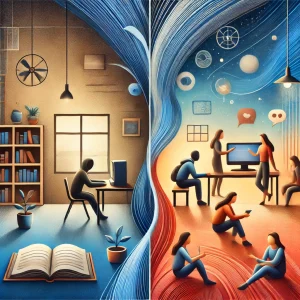Introduction to 3D Kanojo: Real Girl

Hey there! Have you ever heard of "3D Kanojo: Real Girl"? If not, you're in for a treat. This anime dives deep into the complexities of high school romance in a way that's both touching and relatable.
So, what's "3D Kanojo: Real Girl" all about? Well, it’s an anime adaptation of the manga by Mao Nanami. The story revolves around Tsutsui Hikari, a high school student who's more comfortable with virtual worlds than the real one. His life takes an unexpected turn when he meets Igarashi Iroha, a girl who's everything he’s not—socially adept, stunningly beautiful, and very much real. The unlikely pair finds themselves drawn to each other, sparking a romance that challenges their preconceived notions about life and love.
Origin-wise, "3D Kanojo: Real Girl" started as a manga serialized in Kodansha's Dessert magazine from 2011 to 2016. The anime adaptation premiered in 2018, captivating audiences with its unique blend of humor, drama, and heartfelt moments. The animation was handled by Hoods Entertainment, bringing the characters and their world to life with vibrant colors and expressive detail.
Now, you might be wondering why this particular anime has garnered so much attention. For starters, it’s the authenticity of the characters. Unlike the typical high school romance tropes, Hikari and Iroha are refreshingly real. Hikari's awkwardness and Iroha's straightforwardness make their interactions feel genuine, resonating with viewers who see parts of themselves in these characters.
Additionally, the themes of acceptance and personal growth are universal. Watching Hikari step out of his comfort zone and learn to navigate the complexities of real-world relationships is both inspiring and relatable. It’s a journey that many of us have experienced, making the story all the more impactful.
Moreover, the anime doesn’t shy away from tackling deeper issues. It explores how past traumas and insecurities shape who we are and how love and friendship can be powerful forces for change. This depth adds layers to the narrative, making it more than just a simple love story.
"3D Kanojo: Real Girl" has also found popularity due to its beautiful animation and engaging soundtrack. The visuals are stunning, capturing the emotional nuances of the characters, while the music enhances the storytelling, drawing viewers deeper into Hikari and Iroha's world.
In terms of relevance, "3D Kanojo: Real Girl" stands out because it offers a fresh perspective on romance. It reminds us that love isn’t always perfect, but it’s the imperfections that make it real and worthwhile. This message has struck a chord with audiences worldwide, ensuring the anime's place in the hearts of many.
Plot Overview

Hey, have you ever wondered what makes "3D Kanojo: Real Girl" so captivating? Let me take you through the journey of this heartfelt anime. The story kicks off with Tsutsui Hikari, a high school boy who's more into virtual reality than the actual world. He's labeled as an otaku and often finds himself isolated from his peers. His life takes a dramatic turn when he encounters Igarashi Iroha, a girl who’s everything he isn't – outgoing, beautiful, and surrounded by friends.
The main storyline centers around Hikari and Iroha’s unlikely romance. It all begins when Hikari is forced to clean the school pool as punishment. There, he meets Iroha, who’s also serving detention. Despite Hikari’s initial reluctance and judgmental attitude, Iroha's bold and straightforward nature piques his interest. This marks the beginning of their intriguing relationship.
As they start spending more time together, Hikari learns about Iroha's difficult past. She's been through a series of relationships, each leaving a mark on her. Despite her seemingly perfect exterior, she’s dealing with deep emotional scars. This revelation is a turning point for Hikari. He realizes that behind her confident facade, Iroha is vulnerable and in need of genuine connection.
Their relationship faces several key events and challenges. One of the major turning points is when Iroha reveals that she’s moving away in six months due to her father's job. This news shakes Hikari, who has just begun to understand and cherish his feelings for her. Determined not to lose her, he decides to make their remaining time together meaningful, leading to some of the most heartfelt moments in the series.
Throughout the anime, we witness Hikari's growth from an awkward, introverted boy to someone capable of facing his fears and standing up for what he believes in. His development is closely tied to his interactions with Iroha, who, in turn, learns to open up and trust someone sincerely.
Another significant event is when Hikari’s classmate, Ayado, confesses her feelings for him. This situation tests Hikari and Iroha's relationship, as Hikari must navigate his feelings and make a choice that respects both Ayado and Iroha. It’s a delicate balance, and watching Hikari handle it with maturity adds depth to his character.
The central romance between Hikari and Iroha is the heart of "3D Kanojo: Real Girl." It’s not just about falling in love but about the challenges and growth that come with it. Their relationship teaches us about acceptance, resilience, and the importance of seeing beyond the surface.
Every episode brings them closer, exploring themes of loyalty, understanding, and the courage to embrace one’s true self. Hikari’s journey is relatable, especially for those who have ever felt out of place or struggled with self-acceptance. Meanwhile, Iroha’s character reminds us that everyone has a story, and sometimes, the most confident people are those who need the most love and understanding.
Character Profiles

Hey there! Let's dive into the fascinating world of "3D Kanojo: Real Girl" by getting to know the main characters a bit better. First up, we have Tsutsui Hikari. Hikari is your typical high school otaku, more comfortable with his virtual life than the real one. He's socially awkward, shy, and often finds himself the target of bullies. But beneath his introverted exterior, Hikari has a heart of gold. He's loyal to his friends and has a strong sense of justice, even if he struggles to express it.
Hikari's life takes an unexpected turn when he meets Igarashi Iroha. Now, Iroha is quite the opposite of Hikari. She's outgoing, popular, and incredibly beautiful. But don’t let her looks fool you. Iroha has a tough exterior because of her tumultuous past and the emotional baggage she carries. She's been through multiple failed relationships, which has made her wary and somewhat cynical about love.
So, what happens when these two very different people cross paths? Well, their relationship starts off rocky. Hikari, used to being judged and ridiculed, is skeptical of Iroha’s intentions. But as they spend more time together, he begins to see the real Iroha, someone who’s vulnerable and in need of genuine connection. This realization marks the beginning of Hikari’s emotional growth. He starts stepping out of his comfort zone, learning to trust and open up to others.
Iroha, on the other hand, finds in Hikari someone who sees beyond her beauty and popularity. Hikari’s sincerity and honesty touch her, helping her heal from her past wounds. Through her interactions with Hikari, Iroha learns to let down her guard and embrace her true self. Their evolving relationship is heartwarming, showcasing how love can transform and heal.
Their characters are further enriched by their interactions with other characters. Take Ito Yuto, for instance. Yuto is Hikari’s only friend at the beginning, a fellow otaku who shares his love for anime and games. Their bond is strong, built on mutual understanding and shared interests. Yuto is supportive of Hikari’s relationship with Iroha, offering advice and encouragement, even though he has his own struggles with confidence and social acceptance.
Then there’s Ayado Sumie, a classmate who harbors feelings for Hikari. Ayado’s presence introduces a love triangle, adding complexity to the story. Her character is sweet and earnest, and her feelings for Hikari challenge him to confront his own emotions and make difficult choices. Through Ayado, we see another side of Hikari – his sense of responsibility and his desire to do the right thing, even when it’s hard.
On Iroha’s side, we have characters like Takanashi Arisa, her best friend. Arisa is fiercely protective of Iroha, often acting as her confidante and support system. Their friendship is a crucial element of the story, highlighting Iroha’s softer side and her capacity for deep, meaningful connections. Arisa’s unwavering support helps Iroha navigate her relationship with Hikari, offering advice and a shoulder to lean on.
In essence, the characters in "3D Kanojo: Real Girl" are beautifully flawed and deeply human. Hikari’s journey from a reclusive otaku to a caring boyfriend and Iroha’s transformation from a guarded beauty to a vulnerable young woman are central to the narrative. Their interactions with each other and with the supporting characters enrich the story, making it a compelling exploration of love, friendship, and personal growth.
Themes and Motifs

Hey, let’s dive into the rich tapestry of themes and motifs in "3D Kanojo: Real Girl." This anime is more than just a romance; it’s a deep exploration of love, acceptance, and personal growth.
First, let’s talk about love. At its core, "3D Kanojo: Real Girl" is a love story, but it’s not your typical high school romance. It’s about the kind of love that helps you grow and become a better version of yourself. Hikari and Iroha’s relationship starts with a lot of misunderstandings and insecurities. Hikari is a shy otaku who’s been bullied for his interests, while Iroha is a popular girl with a tough exterior hiding her emotional scars. Their love story is all about breaking down these barriers and finding true connection. Through their ups and downs, we see how love can be a powerful force for change, helping them to accept themselves and each other.
Next up is acceptance. Hikari and Iroha both struggle with being accepted for who they really are. Hikari is often judged for his otaku lifestyle, and Iroha is misunderstood because of her beauty and past relationships. The anime does a great job of showing how important it is to accept people for who they are, not who you think they should be. Hikari learns to stand up for himself and his passions, while Iroha finds someone who loves her unconditionally, flaws and all. This theme is especially resonant for anyone who’s ever felt like they don’t quite fit in.
Personal growth is another major theme in "3D Kanojo: Real Girl." Throughout the series, both Hikari and Iroha go through significant transformations. Hikari starts off as an introverted, socially awkward teen, but as he opens up to Iroha and faces various challenges, he becomes more confident and assertive. Iroha, on the other hand, learns to trust and let her guard down, showing a more vulnerable side of herself. Their journey is a beautiful depiction of how relationships can help us grow and become better people.
Now, how are these themes portrayed in the anime? The storytelling is nuanced and heartfelt, with moments of humor, drama, and genuine emotion. The anime doesn’t shy away from showing the awkward, messy parts of love and personal growth. For instance, Hikari’s struggles with his feelings and Iroha’s emotional baggage are depicted with sensitivity and realism. The character interactions feel authentic, making their development all the more impactful.
When we compare "3D Kanojo: Real Girl" to similar works in the romance genre, a few things stand out. Unlike many high school romances that focus on idealized love, this anime presents a more realistic and relatable portrayal. It’s not just about the sweet moments, but also the challenges and obstacles that come with relationships. This approach sets it apart from other romantic anime that might focus more on the fantasy of young love. Additionally, the character development is more profound, with both Hikari and Iroha experiencing significant growth throughout the series.
Another point of comparison is how "3D Kanojo: Real Girl" handles the theme of acceptance. While many romance anime touch on this theme, few do it as deeply as this one. The anime explores not just romantic acceptance but also self-acceptance, which adds a layer of depth to the story. It’s about learning to love yourself before you can truly love someone else, a message that resonates strongly with viewers.
Reception and Impact

Hey there! Let’s talk about how "3D Kanojo: Real Girl" has been received and the impact it has made. This anime has garnered a lot of attention, both from critics and fans alike.
First off, let’s dive into the critical reception. "3D Kanojo: Real Girl" has received generally positive reviews from notable sources. Critics have praised the anime for its refreshing take on high school romance, highlighting its realistic portrayal of teenage relationships. The character development, particularly of Hikari and Iroha, has been widely appreciated. Reviewers often mention how the anime tackles complex emotions and situations with sensitivity and depth, which sets it apart from more stereotypical romantic comedies. The animation quality and soundtrack also received favorable comments, adding to the overall positive critical response.
Now, moving on to fan reactions. In Japan, "3D Kanojo: Real Girl" quickly gained popularity among viewers. Fans love the relatability of the characters and the genuine depiction of their struggles and growth. The anime’s mix of humor, drama, and heartfelt moments has resonated with a broad audience. On social media and various anime forums, you’ll find fans discussing their favorite scenes, character arcs, and the emotional impact of the series. The chemistry between Hikari and Iroha is a frequent topic, with many fans rooting for their relationship and celebrating their journey together.
Internationally, the anime has also found a solid fanbase. With the rise of streaming platforms, "3D Kanojo: Real Girl" has reached audiences worldwide. Fans from different countries have expressed their admiration for the anime’s honest storytelling and relatable themes. It’s always interesting to see how viewers from diverse backgrounds connect with the characters and their experiences, further proving the universal appeal of the story.
In terms of influence on pop culture, "3D Kanojo: Real Girl" has made a noticeable impact within the anime community. The series has sparked discussions about the portrayal of otaku characters in media and the challenges they face. It has also highlighted the importance of authentic character development in romantic narratives. The anime’s success has paved the way for more stories that delve into the lives of introverted and socially awkward individuals, giving them a voice and representation in the media.
The legacy of "3D Kanojo: Real Girl" is evident in how it continues to be a reference point for other works in the genre. It’s often mentioned alongside other popular romantic anime for its unique approach and emotional depth. The series has also inspired fan art, cosplay, and various fan-made content, showcasing the lasting impact it has had on its audience.
What’s particularly interesting is how the anime has encouraged viewers to reflect on their own experiences with love and acceptance. Many fans have shared personal stories about how the series helped them understand and navigate their own relationships. This level of connection and influence speaks volumes about the anime’s reach and significance.
So, if you’re curious about an anime that has touched hearts and made waves both in Japan and internationally, "3D Kanojo: Real Girl" is definitely one to watch. Its blend of humor, heartfelt moments, and realistic portrayals has left a lasting mark on the anime landscape, and it continues to be celebrated by fans around the world.
